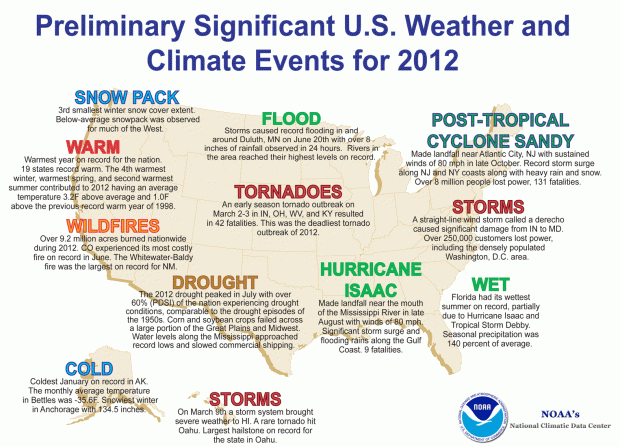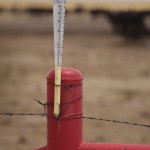Record Hot Year Could Just Be the Middle of a Record Drought
As you’ve probably heard by now, the numbers are in: 2012 was the warmest year in recorded history for Texas (technically tied with 1921, due to rounding) and the country as a whole. New data from the National Oceanic and Atmospheric Administration (NOAA) show that 2012 was a full 3.2 degrees Fahrenheit above average, and a full degree hotter than the previous record year, 1998.
Smell climate change? You’re not wrong. The record warmth is part of an established trend linked to growing emissions of heat-trapping gases. “Climate change is a fairly large part of it,” State Climatologist John Nielsen-Gammon says. “There’s some contribution from La Niña, which tends to make for warmer temperatures, especially in the winter time. But we’ve seen temperatures statewide go up about a degree, a degree-and-a-half, Fahrenheit since the 1970s.” While 2011 had a record hot summer, overall temperatures were warmer this past year.
Extreme temperatures make extreme weather much more likely. NOAA notes in its new report that “2012 was the second most extreme year on record for the nation. To date, 2012 has seen 11 disasters that have reached the $1 billion threshold in losses, to include Sandy, Isaac, and tornado outbreaks experienced in the Great Plains, Texas and Southeast/Ohio Valley.”
On top of that, Texas is currently in a multi-year drought, with some parts of the state especially hard-hit. 95 percent of the state is in some level of drought, according to the latest US drought monitor map out today, with the state’s reservoirs only 65 percent full, according to the Texas Water Development Board.
And water battles are heating up across the state. Conflicts on Medina Lake (9 percent full) and the Highland Lakes of Central Texas (41 percent full), are pitting cities against agriculture. Within the last week, two high-profile water rights cases made news. In one, a county in North Texas is suing Oklahoma for water from the Red River, a case now headed to the US Supreme Court. In the other, Texas has asked the Supreme Court to hear their grievances over a similar water compact conflict with New Mexico.
Pressure is on the state legislature, which convened this week, to act. One proposal gaining traction is to take $1 billion out of the flush Rainy Day Fund to start a “water infrastructure bank” that could help jump start water supply projects throughout the state. Other ideas have focused on funding more conservation efforts.
So what does the immediate forecast call for?
While Texas is likely to get hotter, it isn’t yet clear what’s happening with the current drought. It could end up being one on par with, or worse, than the drought of record of the 1950s, Nielsen-Gammon, the State Climatologist, warns.
“Of course we didn’t do a real good job this past year predicting La Niña [the weather patten largely responsible for the drought],” he says. “This Spring, getting into May or June, things are set up to do one thing or the other. So about the time when we’re either getting or not getting rain during the wettest time of the year, is when we’ll find out how the odds are going to stack up for the following winter,” he says.
If a La Niña returns this fall, it could spell more trouble for an already-parched Texas.
“That’s really going to tell the story about whether this is going to be a three-year drought,” Nielsen-Gammon says, “or something worse than that.”




